| Main Page : About Me : Advice : Articles : Books : Curiosities : Paintings : Photographs : Seminars : Source of Life : Svetlana : Video |
The Source of Life
Part 8+. Magic goes on
Photographs taken by my wife Svetlana de Rohan-Levashov
|
Everything changes in our domain so quickly that I find it difficult to put into words right away. "The Source of Life-8" was still in the process of writing, as new, interesting, sometimes unbelievable phenomena continued to happen almost every day. The last pictures for this article were dated April 14, 2009, but very soon new events worthy of reporting to a curious reader appeared! However, the matter here is not so much in satisfying curiosity, as in the fact that some new phenomena which have never been observed before manifested themselves within days of my finishing the article. Well, let me tell everything step by step, as soon as new information came to me. To put it more precisely, I already had it when the article was nearly finished and if I had decided to include it then it would have been the third time of adding new facts to the already written text. So, the writing of the article would tend to became “eternal” and in order to avoid this I decided to finish it the way it was and write the continuation later, which I do now. It was already clear on April 12 why one of the Japanese maples has the name "Fire glow". Its long filigree leaves acquired a very pronounced scarlet colour and if we imagine them swaying in the breeze, we will see the tree as if seized with living flame, which, however, does not burn, but bears life (Fig. 238). The illusion of a glowing fire is absolute here. It is really amazing that Nature could create this kind of thing! It is highly likely that this is the way the tree scares away herbivorous animals which, like any living thing, are afraid of death-bearing flame. The breeze would only have to "play" with such ominous leaves from time to time and no animal would dare even to approach this "flaming" tree (Fig. 239). Inflorescences appeared on another Japanese maple – "Green lace", the leaves of which have already acquired their due form (Fig. 240) and the maple can finally wear its elegant clothes (Fig. 241)! Actually all "Japanese" showed a striking unanimity this year. On April 12 the buds of Japanese cherry "Kanzan" had already stormily blossomed. As has become a usual phenomenon, the number of flowers on the cherry which look very like a rose (and this is hardly surprising, because they are close relatives) are several times greater than they are outside the active area of the psi-field generator. Every flower of the cherry is filled with sunlight and air (Fig. 242) and more and more of them open with every passing day (Fig. 243). By April 18 all the buds blossomed fully and created the impression that someone "wrapped" the branches in a lacework of strange pink "snow" which in addition exudes an inimitable aroma (Fig. 244 and Fig. 245). In the second half of April all inflorescences blossomed on Lusitanian cherry-laurel and also created an amazing aroma in the vicinity (Fig. 246 and Fig. 247). |
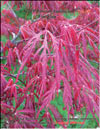
Fig.238 |
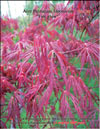
Fig.239 |
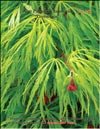
Fig.240 |
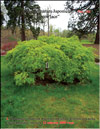
Fig.241 |
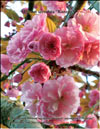
Fig.242 |

Fig.243 |
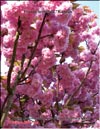
Fig.244 |
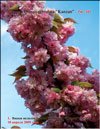
Fig.245 |
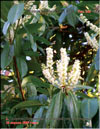
Fig.246 |
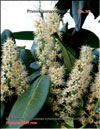
Fig.247 |
|
Chestnuts are thickly covered with inflorescences (Fig. 248), which are so huge that the branches are bent under their weight and create the impression that they are making an elegant court bow (Fig. 249 and Fig. 250) and the white-rose "cuffs" of their green "jerkins" are perfumed with an exquisite scent! Each flower of these extraordinary large inflorescences is both amazingly beautiful and considerably bigger than their "colleagues" outside our domain (Fig. 251)! Paulownia tomentosa Imperialis surprised us this year too. According to reference data it flowers at the end of May before the leaves. Our Paulownia Imperialis began to flower at the beginning of April (Fig. 252). More and more flowers blossomed with every passing day and the merry-go-round of flowering went on and on despite the fact that Paulownias do not usually bloom for more than ten days (Fig. 253) In addition to this "anomaly" – long-term flowering – our Paulownias presented another surprise this year: the unbelievable size of the flowers (Fig. 254). According to reference data Paulownia’s flowers achieve 4-5 cm maximum and in our domain they got to almost 9 cm (Fig. 255)! In other words our Paulownias have flowers twice as big as any other Paulownias in the rest of the world. Moreover, all the flowers of our Paulownias are very large, not just one "mad" flower, and here is the proof (Fig. 256). The first young leaves only appeared on the branches at the end of April (Fig. 257) |

Fig.248 |

Fig.249 |
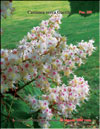
Fig.250 |
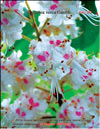
Fig.251 |

Fig.252 |
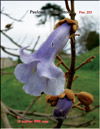
Fig.253 |
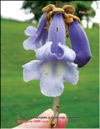
Fig.254 |
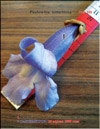
Fig.255 |

Fig.256 |

Fig.257 |
and in the beginning of May still remained very young and small in comparison with flowers (Fig. 258).In fact, this is a unique phenomenon, because this kind of thing cannot happen! Flowers and leaves should not appear on Paulownias at one and the same time. Nobody has ever seen anything like this! Certainly, a specialist or a person well acquainted with this plant may feel justifiably surprised and unable to estimate the incredibility of this phenomenon in full measure: flowers with leaves on the branches, for Paulownias, means almost the same as the appearance of apples before blossom would mean for apple trees. By the way, the reference data indicates that Paulownia’s buds die even in light frosts. In our case neither January frosts nor February icing (and the following night frosts) had any influence on the buds which began to blossom at the beginning of April! So, the “wonders” continue to happen and evolve! More and more blossoming flowers appeared on the branches and our Paulownia path began to look more and more fairytale with every passing day (Fig. 259). And if we take into account that their flowers within the bounds of our domain are two times bigger than they should be according to reference data, then they do look truly magical (Fig. 260)! In order to cast aside any doubts, look at them one more time (Fig. 261). It is of interest that by May 10 there were a lot of buds which had just begun to blossom and which had not opened up yet (Fig. 262). From May 2 to 10 the leaves grew notably, and this is even more surprising, because leaves and blossoming flowers should be observed developing on Paulownias’ branches at one and the same time! The leaves appeared on the Chinese ash-tree (Ailanthus altissima) in the second half of April. They have a very unusual form and colour (Fig. 263 and Fig. 264). It is of interest that the reference data states that the Chinese ash-tree is very sensitive to frosts, but the fact that this plant continues to grow after several frosty winters when the temperature s ometimes reached 20 degrees Celsius below zero as if nothing happened is really amazing! Our next hero is Laburnum "Vossi" (Laburnum x watereri "Vossi"). Although it is frost-resistant, it flowers at the end of May or beginning of June. However, within the bounds of our domain it began to flower in the second half of April (Fig. 265 and Fig. 266)! At that, I would like to say that March and April of 2009 were not warm at all; the days became sunny and warm only at the end of April. The Spiny broom (Calicotome villosa) flowered dramatically in the second half of April too, but again, it should not blossom earlier than at the end of May or beginning of June (Fig. 267 and Fig. 268). |

Fig.258 |

Fig.259 |
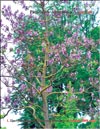
Fig.260 |
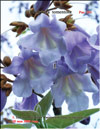
Fig.261 |
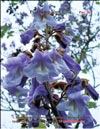
Fig.262 |
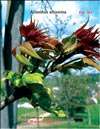
Fig.263 |
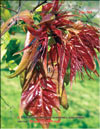
Fig.264 |
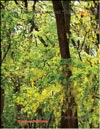
Fig.265 |
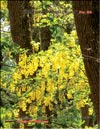
Fig.266 |
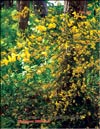
Fig.267 |
|
The devil’s walking stick (Aralia spinosa), the Motherland of which is the East coast of North America, grows on moist, well drained and rich forest soils on the banks of rivers together with other leafy trees and flowers from the end of July to the beginning of August! So, the psi-field generator made the devil’s walking stick send forth its panicles in the second half of April (Fig. 269)! It flowers in its Motherland at the height of summer, and in our domain — at the height of spring (Fig. 270 and Fig. 271), which means that the flowering shifted back a whole season! It is also of interest how old plants reacted to the influence of the psi-generator. Many of them did it in the sixth year of its working! Therefore, common sense suggests the following fully grounded conclusion: the younger the plant, the faster it reacts to the generator’s psi-influence! Araucaria – the Monkey puzzle tree (Araucaria araucana) – gives us an example which allows us observe it the clearest way possible. In 2005 we planted several Araucarias of different size, which means of different age (Fig. 272) (more about this exotic plant in "The Source of Life-5"). So, it was younger trees which reacted first to the psi-generator, the last one which reacted was the biggest tree of all nursery transplants, which means the oldest one (Fig. 273). This Araucaria reacted in May of 2009. Its reaction was very pronounced – even the young trees responded to the generator considerably less. This tree flowered for the first time in May, 2009 and had a multitude of flowering cones; we can see it even has four cones on one and the same branch (Fig. 274 and Fig. 275). Unlike it, younger Araucarias had their third harvest of cones in the beginning of April (Fig. 276 and Fig. 277). |
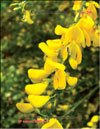
Fig.268 |
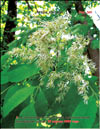
Fig.269 |
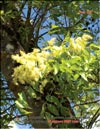
Fig.270 |

Fig.271 |

Fig.272 |
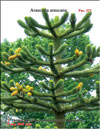
Fig.273 |
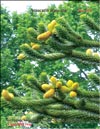
Fig.274 |
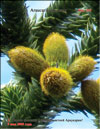
Fig.275 |

Fig.276 |
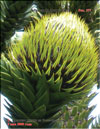
Fig.277 |
|
Wisteria (Wisteria chinensis), a treelike deciduous subtropics liana, bloomed at the end of April (Fig. 278). Its inflorescences are very long and hang down from stems forming flowering and fragrant islands (Fig. 279 and Fig. 280). Another variety – Wisteria chinensis f. Alba bloomed in the middle of May (Fig. 281 and Fig. 282). The still young leaves of the tulip tree reached a considerable size by the beginning of May (Fig. 283). Judas-tree (Cersis siliquastrum) blooms with enthusiasm too (Fig. 284). According to reference data it is able to endure brief frosts to -18-20 degrees. But this kind of frost lasted almost two weeks this year supplemented with a thick snow cover and followed by complete icing! Nevertheless, all these weather "charms" did not exert any ruinous influence on this plant for one and the same reason — the arboreal sap "just" did not freeze in the active area of the psi-field generator (Fig. 285)! The maple effloresced a month earlier than usual (Fig. 286). In short, all plants – trees, bushes, perennial and annual herbs of different climatic zones (from temperate to subequatorial) – bloom almost simultaneously and very abundantly. The flowers of almost all plants are several times bigger than in any other place on the planet! Isn’t it surprising? Doesn’t it make our domain a magical island within an ordinary world!? Magnolias continue to please our eyes. Enormous and wonderful buds which could charm anyone with their beauty and unusual appearance show up on the branches of many nursery trees. The buds of Magnolia Liliflora "Orchid", which are indeed reminiscent of orchids, began to blossom in the second half of April. Their petals are enormous and very dense and create the impression that you are looking at a flower made of a semiprecious stone which somehow "came alive" (Fig. 287). |
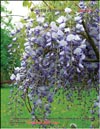
Fig.278 |
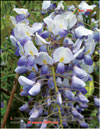
Fig.279 |
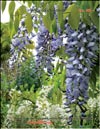
Fig.280 |
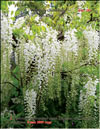
Fig.281 |
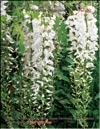
Fig.282 |
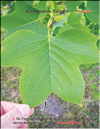
Fig.283 |
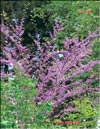
Fig.284 |
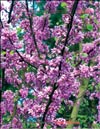
Fig.285 |
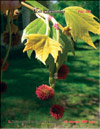
Fig.286 |
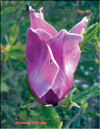
Fig.287 |
|
There is another amazing flower next to this beauty – Magnolia "Angel skin", the velvety white-rose petals of which indeed look like a velvet skin. We have to trust those who gave the name to this variety of Magnolia that the skin of angels, which I personally have never seen, looks just like this. Most likely, the unusual colour and form created the impression of something from another world (Fig. 288). Another magnolia surprised us this year. A very rare Magnolia "Elvina" did not give any signs of life in the spring of last year and remained in this state the whole summer and autumn. Moss began to cover its lifeless branches, but in April of 2009 the already dead tree came back to life and produced buds which soon blossomed (Fig. 289). Young leaves appeared too and the most interesting thing is that the buds and leaves did not appear on young shoots which logically could be expected, but on the already dead branches (Fig. 290). The reviving process of the dead nursery plant took place very stormily under the influence of the psi-field generator. By the beginning of May Magnolia "Elvina"’s branches were decorated both with beautiful flowers and numerous strong and fleshy young leaves (Fig. 291). This is the third case of plant "resurrection" since the program of regeneration was introduced into the generator to revive the bicentenary sequoia which was officially acknowledged dead and about which I have written in previous articles. Magnolia "Ricky" blossomed at the end of April and its gently-rose petals froze in the fairy dance of life and sun (Fig. 292) which had just begun (Fig. 293) and in which some uninvited guests wished to join (Fig. 294). Magnolia "Lotus" buds began to wake up at the end of March (Fig. 295). By the middle of April the young leaves had grown considerably, but were still unopened (Fig. 296) and only by the middle of May did they finally unfold into a fan, although still remaining light-green with a rose tint which is inherent in young leaves of this magnolia (Fig. 297 and Fig. 298). |
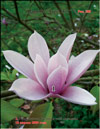
Fig.288 |
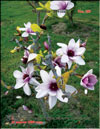
Fig.289 |
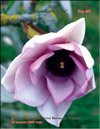
Fig.290 |
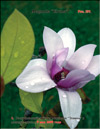
Fig.291 |
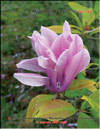
Fig.292 |
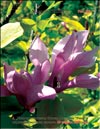
Fig.293 |

Fig.294 |

Fig.295 |
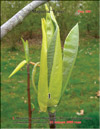
Fig.296 |
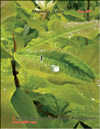
Fig.297 |
|
The most incredible thing is that the buds began to open at the beginning of May (Fig. 299), and the size of leaves and buds is impressive, although they are still very young (Fig. 300). The petals become whiter and whiter with every passing day (Fig. 301 and Fig. 302) and the banana-strawberry scent around these magnolias has increased also with every day. In earlier years Magnolias "Lotus" did not blossom earlier than June, but this year it is already enthusiastically flowering at the beginning of May and has numerous buds among young leaves (Fig. 303). Their size is very impressive – the leaves are still to grow, but now they are already 50 cm long (Fig. 304)! By the middle of May the buds of the "second wave" appeared among continuously growing young leaves. They are considerably bigger than that of the "first wave" (Fig. 305)! It is of interest that the petals of the buds are light-green and as they bloom, they gradually turn white and become snow-white when open completely. Let us enjoy the young leaves of Magnolia "Lotus" which are more than half a meter long now and continue to grow (Fig. 306) and the petals of its snow-white flowers (Fig. 307). |
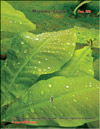
Fig.298 |
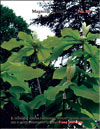
Fig.299 |
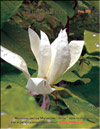
Fig.300 |

Fig.301 |
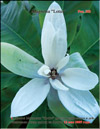
Fig.302 |
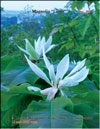
Fig.303 |
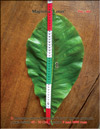

Fig.305 |
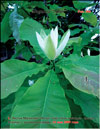
Fig.306 |
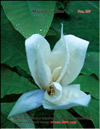
Fig.307 |
|
Just several days passed since I wrote "The Source of Life-8" "The Source of Life-8" and the leaves of the silver linden-tree grew considerably (Fig. 308). We can trace how the leaf size changes, looking at photos which were taken successively (Fig. 309, Fig. 310 and Fig. 311). We can notice that the leaves are very large and grow like a weed, but also have an extraordinarily dense structure and a wax-like coating. When the size of leaves and flowers and the number of fruits changed sharply in the active area of the psi-field generator for the first time, their thickness remained the same. So, the leaves of half a meter began to loose their strength and form. Obviously, Nature did not count on such a size and did not prepare. Therefore, in order that leaves, petals and branches could sustain the loads I introduced an additional correction into the generator. It was intended for increasing the thickness of leaves and petals proportionally to their size and to strengthen their "skeleton" and the resiliency of branches and proved to be very successful! You can see it for yourself looking at this year's leaves and flowers. In the past the enormous leaves and petals were unable to sustain their own weight: the vegetable biomass was more than the natural "skeleton" of plants and petals could bear. As a result of the correction this problem disappeared! Leaves and petals, even being much larger than before, do not sag. At the same time, they both became more dense and strong and acquired a special waxy coating which considerably diminishes the evaporation of water from their surface! Thus, the change of leaves and petals took place in two stages: first, leaves and petals became bigger and then their density and thickness increased. As different plants reacted to the influence of the psi-field generator non-simultaneously, each plant passed these stages at a different time! The delay of the reaction to the psi-field generator does not depend only on the type of a plant, but also on its age. It is the age of each plant that determines the inertia of its reaction! The older the plant, the later it reacts to the influence of the psi-field generator, which is quite natural! An older plant was initially formed in ordinary conditions and then was included in the active area of the psi-field generator and young nursery plants were formed there from the very beginning! So, adult plants had to spend some time re-constructing themselves for the dramatically different conditions created by the dark matter generator, while young plants did not need to do this as they grew in the generator’s working area from the beginning!.. The leaves of figs promised to grow strong and enormous this year. However, it was not leaves that greatly surprised us, but ripening figs, because they already cannot be called ovaries! Well, let me tell everything one after another. As I already mentioned, the figs’ ovary next appeared in the first days of April before new leaves came out of swollen buds. Thus, the annual cycle of fig-trees fruiting was terminated! Ovaries appeared continuously during the year: in spring, summer, autumn and winter. The only seasonal difference in fruiting was the speed of ripening, and that was all! In summer we observed three generations of figs hanging on the branches! As I already explained before, the speed of the ripening depends on the speed of the arboreal sap, which, in its turn, depends on the external temperature. So, it was precisely the temperature of the environment that determined how quickly fruits ripen and how many generations can be found on the branches simultaneously! However, our figs ripened throughout the year and this is incredible! I have already introduced the program which changes the fluidity of the arboreal sap and takes the temperature of the external environment into account. Now we should observe whether it will be successful and get the desired result from the initial intention. It is highly likely that the correction already works, if we pay attention to the speed of growth of figs. By the middle of April (April 14) young leaves of fig-trees appeared from the buds and promise to be enormous (Fig. 312). Just several days passed (April 18) and young fleshy leaves did not grow much, but the figs “put on weight” quite notably for the same period of time (Fig. 313). By the end of April (April 29) the young leaves began to grow very fast and reached an impressive size, so impressive that the intensively growing figs do not look as enormous as they did earlier. It does not mean that they began to develop poorly or stopped doing this at all. It’s just young leaves began to grow with greater speed than fruits (Fig. 314). We can clearly see the strength and density of the leaves in their every vein which feeds the leaf with life-giving sap. If we enlarge the image we can see a cell of the leaf pierced with sunlight as if shining from within. The number of young leaves is still small, but there is an impressive quantity of figs on the branches (Fig. 315). And these are still quite young trees! Despite the fact that they grow from 5 to 6 times quicker than their "colleagues" outside the active area of the psi-field generator, such an amount of fruit is still incredible! In order to be sure that the figs grow with the same impressive speed, see the picture taken on May 3, where the still green fig is enormous (Fig. 316). This is not a result of photography tricks, but the real state of affairs. There are many such figs on the trees (Fig. 317). |
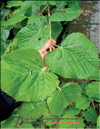
Fig.308 |
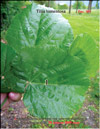
Fig.309 |
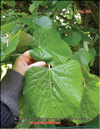
Fig.310 |
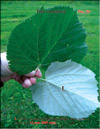
Fig.311 |
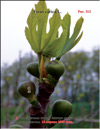
Fig.312 |
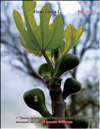
Fig.313 |
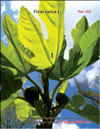
Fig.314 |
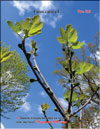
Fig.315 |
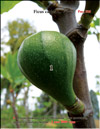
Fig.316 |
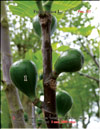
Fig.317 |
|
Some more days passed (May 9) and green figs (in direct and figurative sense of the word) became even bigger (Fig. 318). The fig and the young leaf is clearly visible on the picture, so one does not need to have a perfect imagination in order to picture the size of the fruit, which tightly cover the branches of the trees (Fig. 319). A similar phenomenon is observed in the case of the nursery fig-trees of "Golden" variety: both young leaves and ripening figs are "the best there is" (Fig. 320)! Their branches are stuck all over with quite young but already huge figs (Fig. 321). The most capricious and tender variety – "Bloody" – thoroughly keeps pace with them! No matter how incredible it may seem, its mature figs appeared on the naked branches in the middle of March, 2009! And at the end of April, the new ovaries appeared again and new figs were formed out of them at the beginning of May (Fig. 322). Their number is considerable too and they are intensively saturated with vital force every passing day (Fig. 323). I would like to remind readers that a nursery plant of this variety brought forth figs at the end of October, 2008. This very fact became a sensation, because this variety grows in the very south of Spain and the trees die at a temperature lower than +18 degrees Celsius (more details in "The Source of life–6")! Figs of this variety appeared for the second time in the middle of March, 2009, and it happened for the third time in May! It is highly likely that it is not their last fruiting in 2009 and it will bear fruits all-the-year-round. Let us wait till October and then we will see if this supposition is correct. The fact that three harvests of the heat-loving "Bloody" variety were gathered in autumn, winter and early spring, which were unusually harsh this year and the nursery plants should surely have died, is really amazing! We can just suppose the level of their fruiting activity in summer when the most favourable conditions for their growing are observed in France. Another fig variety – "Moisson" – caught up with other varieties: by the middle of May the ripening figs reached considerable size (Fig. 324). However, it was not just fig-trees which surprised us this spring. As I already mentioned, the gooseberry bloomed in the beginning of April and continued to flower incessantly during the whole of April. As a result of this, mature berries appeared at the end of April (April 29) (Fig. 325)! Isn’t it astonishing – mature gooseberries at the end of April?! The bushes are covered with berries (Fig. 326) which continued to ripen and increase in size. At the beginning of May (May 3) we were able to observe three generation of berries on one and the same cane: mature and ripening berries and young ovaries (Fig. 327 and Fig. 328). |

Fig.318 |
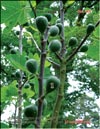
Fig.319 |
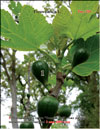
Fig.320 |
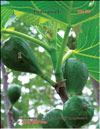
Fig.321 |
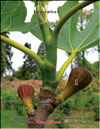
Fig.322 |
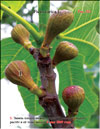
Fig.323 |

Fig.324 |
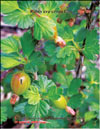
Fig.325 |
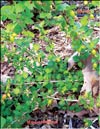
Fig.326 |
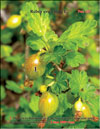
Fig.327 |
|
The gooseberry was not the only "bustler". Clusters of berries appeared on the canes of the red currant in the second half of April (Fig. 329); by the end of April (April 29) they were fully formed (Fig. 330) and began to increase and grow red by the first days of May (May 9) (Fig. 331)! Although the red currants have not reached the enormous size of last year yet, I am sure they will! Besides, it was the berries of the second harvest which grew enormous, so we should wait and observe how the red currant will behave in the generator’s active area this year. However, we have some results even now. This year the tender red currant took the lead over the black currant, but the latter did not think to surrender. The berries began to appear at the end of April (April 29) (Fig. 332) and by the middle of May (May 13) they were fully formed and now fill themselves with life force and continue to grow (Fig. 333). The whortleberry (Vaccinium myrtilus L.) began to blossom in the beginning of May which would seem quite ordinary event, taking into account that according to reference data the whortleberry usually blooms in May or June (Fig. 334). However, there is one "but": the inflorescences appeared simultaneously with the leaves! We can clearly see on the picture that young leaves have just begun to change their colour from light-green-orange to green which indicates that they came out from the buds quite recently, simultaneously with the inflorescences, and this is an incredible phenomenon! The yellow raspberries appeared earlier than the red ones and this is also very interesting (Fig. 335). Although the red raspberry somewhat delayed its blooming, this omission was compensated by exuberance (Fig. 336 and Fig. 337). |

Fig.328 |
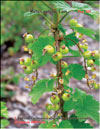
Fig.329 |
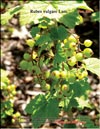
Fig.330 |
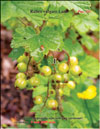
Fig.331 |
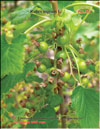
Fig.332 |
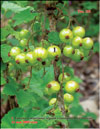
Fig.333 |
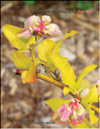
Fig.334 |
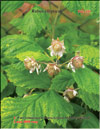
Fig.335 |
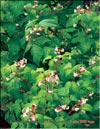
Fig.336 |
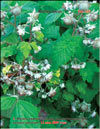
Fig.337 |
|
At the same time, green red raspberries’ neighbour just produced flowers and buds which still prepare for blossoming. Active volunteer-helpers, ground-nesting bees, if I am not mistaken, see to it that the flowering will be not in vain (Fig. 338). So, the harvest promises to be very rich! Incredible things also happened with the strawberry this year. It began to produce berries in the first days of March and has not stopped since. April 9, 2009 was when I mentioned mature strawberries for the last time in the previous article. Then we saw new ovaries, faded flowers and newly blossomed flowers together with mature berries. On April 14 new mature strawberries appeared (Fig. 339). It is of interest that by the middle of April the size of the flowers considerably increased (Fig. 340) which brought its consequences! New berries ripened and new flowers bloomed on April 18 (Fig. 341). The flowers became notably bigger. In order to understand what their size is, it is enough to proportion them with the size of berries (Fig. 342). Impressive, isn’t it!? And now, if we look at the blossoming flowers, we can clearly see that they are considerably bigger than they were ever expected to be (Fig. 343). If we pay attention to how sunlight penetrates into the blossoming flowers, we will have a surprising feeling that it lights little suns inside each flower! These flowers will not produce anything but enormous strawberries – like this one (Fig. 344). However, this was not the only one — all the strawberries are enormous (Fig. 345)! You can make sure of this easily: look at the picture with strawberry next to a match box on the tiled floor, so that you can compare the size of the berry with that of the box and tiles (Fig. 346). Here is another berry in Svetlana’s hand (Fig. 347). |
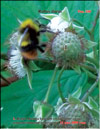
Fig.338 |
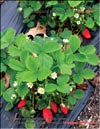
Fig.339 |
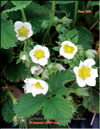
Fig.340 |
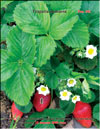
Fig.341 |

Fig.342 |
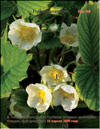
Fig.343 |
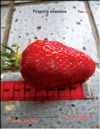
Fig.344 |

Fig.345 |
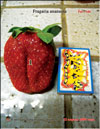
Fig.346 |

Fig.347 |
|
You look at it and begin to feel its aroma which absorbed the force of the sunlight and feel the taste of the sweet pulp without any artificial chemical substances! Even the appearance of the berry makes us draw this conclusion; because the strawberries which usually come from greenhouses are grown in pure chemical additives and look dead even in outward appearance, not to mention the fact that they convert into disgusting mush in several days. Those who continue to doubt the size of our berries can look at the following picture (Fig. 348)! Impressive, isn’t it!? However, we planted a variety of strawberry which has never been remarkable for the size of its berries before. (See the articles of the series "The Source of Life" beginning with the spring of 2005). In the previous years the size of our strawberries increased from year to year, even from one harvest to another, but it was exactly 2009 when they reached such a considerable size. If the matters continue this way in the future, the strawberry will produce berries all the year round and the size of berries will become even bigger in the working area of the dark matter generator. There is one interesting moment in the April strawberry matter: the berries and flowers became enormous after I made the next correction in the work of the psi-field generator the purpose of which was to change the fluidity of the arboreal sap. So, increasing the fluidity led to such unexpected "side effects". In fact the increased fluidity of the arboreal sap results in the acceleration of the exchange processes in the cells of plants with all the following consequences which, by the way, have been already manifested in the strawberry, figs, gooseberry, currant and raspberry! These plants have never had such a number of ovaries and fruits. And here is the quality of these fruits (Fig. 349). We can perfectly see that that the berry is very dense, fleshy and very juicy and... Mouthwatering! In May the temperature increased and although it did not reach 30 degrees Celsius, a usual May heat level for France, the soil has already warmed, and the strawberry boom happened in May! The May strawberry was as big as the April one (Fig. 350), but the number of mature strawberries was awesome – I have never seen anything like this (Fig. 351). Again, mature berries neighbour green ones which are at different stages of ripening – from an ovary to pretty large berries which began to grow red, and there are flowers next to them – those which have just faded, which are still flowering and yet more unopened buds! There are plenty of wild strawberries (Fragaria vesca L.) in our glades this year (Fig. 352), the leaves and flowers of which are several times bigger than outside the bounds of our domain (Fig. 353). If I did not know that I am looking at a wild strawberry, I would confidently say that I am seeing a cultivated strawberry in the picture! I have seen wild strawberries before – the leaves of this plant were small and, accordingly, so were both flowers and berries! In my childhood I often gathered wild strawberries on the slopes of the Caucasian mountain foothills. The berries which we picked there were usually smaller than a match-head and did not ripen earlier than the beginning of June, despite the city of my childhood, Kislovodsk, being situated in an area with an amazingly mild climate and overwhelming number of sunny days per year. A lot of sun and water made the slopes of the mountains near Kislovodsk an ideal growing place for the wild strawberry, so the berries which we gathered were not the worst ones! Certainly, the strawberry has been bred from the wild strawberry through a long process of selection, choosing only those bushes which had the biggest berries, during centuries, if not millennia! However, all the wild strawberry plants have large leaves and flowers within the bounds of our domain, which indicates that considerable changes happened in them in the working area of the psi-field generator, not as a result of breeding! It is highly likely that the size of our mature wild strawberries will be like that of the strawberries that grow outside our domain. We observed this kind of pattern in the case of the strawberry — the bigger the flowers, the bigger the berries. My supposition was confirmed very soon. When I was still writing about the wild strawberry, its first berries ripened. The picture clearly shows that our berries are several times bigger than the usual ones (Fig. 354). But this is just the first harvest (May 17) and the result of the first flowering (April 18), when the flowers were not as enormous as they became at the beginning of May. As the flowering of the wild strawberry continues over more than a month, new berries ripen every several days (May 21) and are bigger than those which have ripened earlier (Fig. 355). The wild strawberry dated May 21 can hardly be called wild strawberry – they are so big and rather look like a small cultivated strawberry! We can surmise what kind of berries will "hatch" from the last flowers of the wild strawberry! The changes happen so quickly that I find it very difficult to describe them as they appear! I just described what was going on with raspberries and then had to write about ground berries as the necessity arose to bring in some additional information. By May 19 robust ovaries appeared on the stems of the red raspberry (Fig. 356) and in just a few days, on May 22, the berries ripened (Fig. 357)! |

Fig.348 |
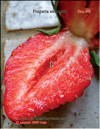
Fig.349 |
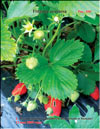
Fig.350 |
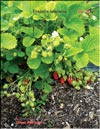
Fig.351 |
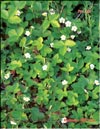
Fig.352 |

Fig.353 |
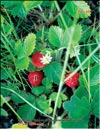
Fig.354 |
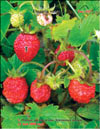
Fig.355 |
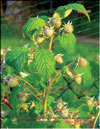
Fig.356 |
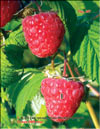
Fig.357 |
|
Mature red raspberries in the second half of May are an incredible phenomenon! Besides, all this does not take place in a greenhouse, but in the open air and without any chemical additives and in soil highly unfit for most plants! Also, the size of the mature berries is staggering! It became commensurable with the size of the leaves which are considerably bigger than their "colleagues" in the rest of the world (Fig. 358). Regrettably, almost all ripened berries were immediately "put to use" and the next day Svetlana succeeded in finding only one mature berry. Its size of more than 3 cm is striking (Fig. 359), although it was not the biggest one! And this is just the beginning when the first berries are never the biggest. However, the red raspberry is not the only one which can boast of considerable changes that happened whilst I was writing the article. The red currants became bigger and redder (Fig. 360). The figs of the "Moisson" variety became enormous and began to grow dark (Fig. 361) – some more sunny days and they will ripen completely! The sunlight is desperately needed, but now there is not much of it, because it is raining almost every day. These are summer rains with thunder and lightning, when a dense wall of water falls from sky and it is as if the earth starts breathing and the air is satiated with stormy freshness. The branches of fig-trees "Golden" are covered with an unbelievable number of ripening figs. Although they are still quite green, they are already very big and sparkle with unbelievable life-force (Fig. 362). Last year the stalks of figs could not sustain their weight and sometimes broke. This year they are much stronger (Fig. 363) and easily cope with their "burden". I hope that the stalks will behave like this in the future too. The ripening figs of "Honey" variety soon will remind one of a small cask of honey (Fig. 364); there are many of them and they all have impressive size (Fig. 365). In fact, these interesting results were manifested after I had introduced the last correction in the working of the psi-generator aiming to increase the fluidity of the arboreal sap with regard to the external temperature, and this is just the beginning of our observations. The change in the fluidity of the sap increases the speed with which it moves along the vessels of the plants both at low and high temperatures. The increase in fluidity resulted in the acceleration of exchange processes in vegetable cells and consequently, in the stormy and abundant fruiting. There is not enough data to draw principle and final conclusions, but this is just the beginning which appears to be very vigorous. The generator is being gradually debugged on the basis of the reaction of the plants to new corrections. New leaves of the Japanese plum have been already formed. They strongly differ from the old ones and not just in colour. Most likely over the course of time the new leaves will be dark-green, but their fleshiness, size and thick wax-like coating sharply distinguish them from their older brothers (Fig. 366). Paulownia Imperialis also showed an unusual reaction this year. This tropical and subequatorial plant usually blooms for ten days maximum, before the leaves appear. But this year the process of flowering is several times longer than it would normally be; the flowers are two or three times bigger than usual; the fruits appeared in place of the first flowers, but the blooming still continues (Fig. 367)! |

Fig.358 |

Fig.359 |
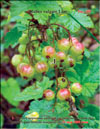
Fig.360 |

Fig.361 |
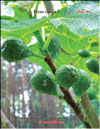
Fig.362 |
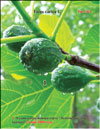
Fig.363 |
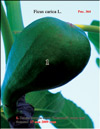
Fig.364 |

Fig.365 |
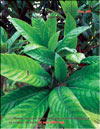
Fig.366 |

Fig.367 |
|
I am sure that nobody ever saw this before — blossoming flowers, leaves and ripening fruits simultaneously on Paulownia’s branches, and this is just May 17 (Fig. 368)! Although the tulip tree bloomed in the middle of May, instead of the end of May or the beginning of June, its flowers amaze with the size and bright colour (Fig. 369). Each flower is two or three times bigger than normal and they really do look very much like tulips (Fig. 370). The flowers are bright-orange at the bottom, but wherever you may look, their elegance and singularity causes sincere admiration (Fig. 371). Wonders with the Arum lily continue to happen. The fact that this particular water plant left the water and came to dry land in May, 2006, like the first Crossopterygian did, is described in "The Source of life–3"). The difference here is that Crossopterygian needed millions of years to turn into the first amphibious plant which, besides, very strongly differed from the forebears, whereas the arum-lily developed dry land at once and did not change its outward appearance at all (Fig. 372). It is also of interest that nobody ever planted them either in the artificially created lake or in the artificially created river in our domain! Besides, the Arum lilies appeared in the glades which are quite far away from our water "spaces". The only logical explanation which comes to mind is that this is related to a very distant past of the area itself. The lime soil indicates that once it was the bottom of a sea which turned into dry land over the course of time. Before its final growing into dry land, the area was covered with bogs and shallow lakes where Arum lilies grew, and a moment came when the seeds could not germinate because the necessary living conditions for these plants disappeared. So, they remained torpid in limestone until I brought the water synthesis program in the psi-field generator. As I mentioned before: the younger the plant, the quicker and more active its reaction to the generator. The torpid seeds of the Arum lily (as well as all other seeds of plants and spores of mushrooms) are an ideal subject for the psi-field generator to influence, and here is why. A spirit of an adult plant is fastened to a seed. It is a proven fact, so I will not explain it in this article and come to the essence of the matter. When the seed germinates, the developing biomass forms the new plant in the image and likeness of a particular plant of a particular variety. Therefore, if one can change the spirit of a plant, then the developing plant will have these changes from the very beginning. In other words the plant will carry new properties and qualities from its birth. If the generator influences a young plant, the latter will react, but with some delay, and the older the plant, the bigger the delay. This is like building a house. If a house is not built yet, we can build it like we want from the very foundation. If the latter is already built, we should re-do it before we begin to build all the rest according to our wish. But if the whole house is already built, we should come to total reconstruction in order to get what we want. Each case requires different time for building of one and the same house. The same works in plants: the least time and effort is required to change the spirit of a plant before the seed germinates; more time and effort is necessary to get the same result in a young plant and still more time and effort will be necessary to change an adult plant. Certainly, each type of plant has its features and inertia of reaction to the influence of the psi-field or dark matter generator; I gave just a general tendency which is confirmed by common sense and practical results. The fact that the bicentenary sequoias which are slow-growing plants (means that they have very high level of inertia) reacted stormily that last year, shows that the psi-field generator compresses the millions of years necessary for a vegetable species to change, into just several years. At the same time the psi-field generator creates such properties and qualities in plants which could never appear in the course of their natural development. Well, let me now come back to the Arum lily and what happened to it. The Arum lily appeared in our domain for the first time at the beginning of May, 2006 – three years after the creation of the generator (Fig. 372) and a year after I introduced the program of water synthesis into the psi-field generator (the end of July, 2005) which gave plants the possibility to synthesize water in order to save them from death during the continuous and strong drought. Almost all plants were saved then and at the beginning of May of the following year the Arum lilies which have never been seen before either within the bounds of our domain or on the banks of the Loire and the nearest lakes, appeared in our glades. The main reason for this is that the Arum lily (Lysichiton camtschatcensis) is a plant of another climatic zone and does not grow in the open in this locality. This is another confirmation of the fact that its seeds have been sleeping from the time when there was a completely different climate in this area! Moreover, the Arum lily changed its properties and qualities, not the outward appearance, which proves once again that it is possible to change a plant qualitatively without changing its appearance. A water plant which became a land one is the best proof! And last, but not least – the seeds of a plant which disappeared long time ago, probably millions of years ago came back to life in dramatically different environmental conditions because of the influence of the psi-field generator. Their "spring" of life could "straighten" up only in the active area of the dark matter generator which both replenished the dormant seeds with life-force and created absolutely new properties and qualities which revived this plant after a millennial sleep. It is also of interest that the Arum lily became much bigger in May, 2008; however, its only petal became very thin so that it seemed to be unable to sustain its own weight (Fig. 373). This kind of phenomenon became already a rule. All plants which came through the increasing of the size of their leaves and flowers in the active area of the generator went through it: in the first year they grow huge but very thin, and became fleshy and strong only the next year. Moreover, they get a wax-like coating which reduces evaporation from the enormous surface of leaves and petals which, besides, are able to synthesize water! The Arum lilies are not an exception: in 2009 their petals are very strong and perfectly hold their form despite their enormous size in comparison with 2006 (Fig. 374). The pistil of the flower became bigger and stronger too (Fig. 375) and the flower reached more than 30 cm (Fig. 376)! Several varieties of wild orchids unexpectedly appeared in the glades this year (Fig. 377 and Fig. 378). |
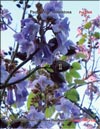
Fig.368 |
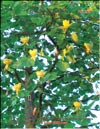
Fig.369 |
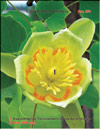
Fig.370 |
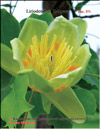
Fig.371 |

Fig.372 |
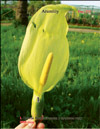
Fig.373 |
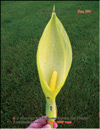
Fig.374 |

Fig.375 |

Fig.376 |
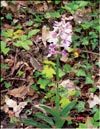
Fig.377 |
|
The more so because nobody has ever planted them, nobody has ever even seen them within the bounds of our domain. The wild orchids appeared both in the glades and in the forest (Fig. 379 and Fig. 380). They all differ in the place of growing — some grew in glades, other in the forest; some boldly show off in bright sunlight, others hide in the shade of the thick crown of a tree. They differ also in the colour of the flowers, their form and size which indicates that different varieties have appeared (Fig. 381). Look at the pictures and judge for yourself (Fig. 382, Fig. 383 and Fig. 384, Fig. 385). This sudden variety causes a certain interest also because wild orchids do not grow outside our domain! So, this is another unexpected result of the influence of the psi-field generator which created the necessary conditions for the sleeping seeds to germinate and turn into full-fledged plants. As the dark matter generator creates necessary conditions for normal development of plants from different climatic zones, the seeds of plants which grew in this area in a different time and epoch come back to life. Our next hero, however from the present time, is the iris (Iris germanica) which should have died because of the very low temperatures last year, but the bulbs survived both the frosts of -20 degrees Celsius and icing. According to reference data irises bloom in summer and their flowers can die even during a summer temperature drop. Owing to the generator’s influence irises’ bulbs and leaves became frost-resistant, and their flowers became considerably less sensitive to the temperature drops. As a result of it, they bloomed enthusiastically at the end of April which is pure incredibility (Fig. 386 and Fig. 387). |
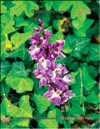
Fig.378 |

Fig.379 |
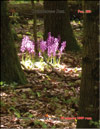
Fig.380 |
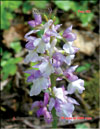
Fig.381 |
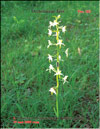
Fig.382 |
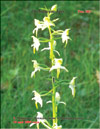
Fig.383 |
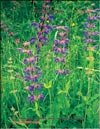
Fig.384 |
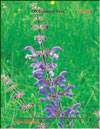
Fig.385 |
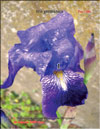
Fig.386 |

Fig.387 |
|
The temperature drops in April and May did not render any influence on flowering irises and these charming plants continue to please our eyes with their amazing flowers. Look at their strikingly bright flowers (Fig. 388 and Fig. 389). The combination of form and colour of the latter flower is so breathtaking that it is almost impossible to take ones’ eyes off its hypnotizing beauty. Daisies surprised us this year too. They began to flower in February and flowered the whole February, March and April (Fig. 390). The fact is that their size increase is visible with naked eye. Their number is surprising too – some of our glades turned into beautiful daisy carpets. Forget-me-nots created delicate carpets on our glades too (Fig. 391). These modest wildflowers always bring recollections of childhood and fill the soul with pleasant warmth with a touch of melancholy, bringing good memories which remain of our past. It is of interest that the name of these flowers in different languages is the same as in Russian. And here we can see the glades of forget-me-nots and involuntarily submerge into pleasant flashbacks to the past and the soul fills with a tender sadness. Well, enough waxing lyrical let us come to … mushrooms! They are also the heroes of this article. New types of mushrooms, both absolutely unknown and well known, continue to appear in glades and the forest within the bounds of our domain. At the beginning of May we saw mushrooms the type of which we could not define yet. Their distinguishing feature is the spotted hat with a nacre shade which strongly reminds one of a shellfish shell (Fig. 392). On the contrary, the next mushroom is very well known — here is the Rose mushroom, the enormous caps of which appeared in the beginning of May (Fig. 393 and Fig. 394). White mushrooms appeared in the beginning of May (Fig. 395)! Last year they emerged in the middle of June, and it was an unbelievable phenomenon then. And this year the white mushrooms "decided" to break their last year's record and showed numerous caps at the beginning of May (Fig. 396). Their size is traditionally huge: the caps of young white mushrooms have a diameter of 30 to 40 cm and this has already become an ordinary phenomenon for us (Fig. 397). |
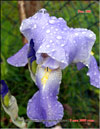
Fig.388 |
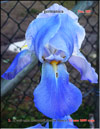
Fig.389 |
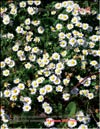
Fig.390 |

Fig.391 |
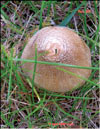
Fig.392 |
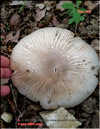
Fig.393 |
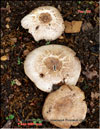
Fig.394 |

Fig.395 |

Fig.396 |
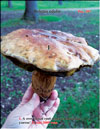
Fig.397 |
|
Young champignons keep pace with the white mushrooms (Fig. 398). The size of their caps is almost the same. By the middle of May we had another new "guest" — Cortinarius triumpauss Fr. from the family Cortinariaceae. The orange-yellow large caps of this edible mushroom look very attractive on the background of bright green glades (Fig. 399 and Fig. 400). Armillaria (Fig. 401) and the scotch bonnet (Marasmius oreades) (Fig. 402) showed up in the middle of May. |

Fig.398 |
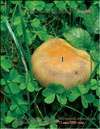
Fig.399 |
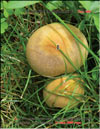
Fig.400 |
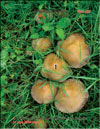
Fig.401 |
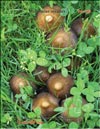
Fig.402 |
|
So, wonders go on in full sail – each new correction or new addition to the functioning of the psi-field generator, which is intended to solve one or another problem, answers with a range of reactions. The phenomena observed in our domain have a qualitatively new nature – nobody solved these kinds of tasks before or even set them theoretically! Therefore, what plants experience and manifest in the active area of the psi-field or dark matter generator happens for the first time and, therefore, a lot of unexpected things happen as by-products or side effects of the main programs, like, for example, the appearance of plants which died out for one or another reason hundreds, thousands or even millions of years ago! So, we’ll see what other plants will return from the eternal sleep next… Nicolai Levashov, May 25, 2009 |
| Main Page : About Me : Advice : Articles : Books : Curiosities : Paintings : Photographs : Seminars : Source of Life : Svetlana : Video |